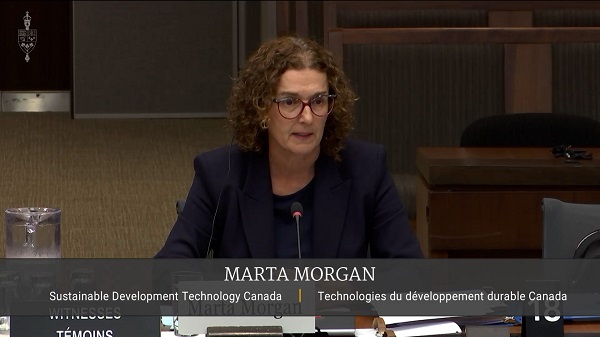National
How Rick Perkins and Larry Brock Revealed a $330 Million Cover-Up While Liberal MPs Run Damage Control

The True Cost of Letting Corruption Slide
Canada’s government is rotting from the inside, and if you needed more proof, look no further than Public Accounts of Canada (PACP) meeting 143. What we witnessed was a showcase of blatant corruption, institutional incompetence, and Trudeau’s Liberal elite running a racket—this time under the guise of environmentalism and “clean tech.” Sustainable Development Technology Canada (SDTC), the so-called green tech fund, has turned into nothing more than a green slush fund used to enrich Trudeau’s cronies while taxpayers foot the bill.
Let’s break it down: Trudeau’s government has turned what should have been a platform to invest in cutting-edge green technology into a cash pipeline for Liberal insiders. The PACP meeting laid bare how $330 million of taxpayer money flowed into conflicted projects approved by board members who had ties to the very companies benefiting from these funds. This isn’t negligence—this is corruption, plain and simple.
The Heroes of Accountability: Larry Brock and Rick Perkins
Two Conservative MPs stood out during this farcical hearing, and thank God they did. Larry Brock and Rick Perkins relentlessly grilled Marta Morgan, the bureaucrat who’s supposed to be in charge of overseeing SDTC. Let’s be real, though—Morgan’s job isn’t about fixing anything. Her role is to protect Trudeau’s insiders, to dodge questions, and to ensure that Canadians never find out the full extent of how deep this rot goes.
Larry Brock didn’t mince words when he compared the SDTC corruption to the Sponsorship Scandal, the Liberal boondoggle from the early 2000s that took down the Martin government. In this case, billions of dollars earmarked for clean technology are being funneled into projects tied to people sitting on SDTC’s board. “This is the sponsorship-style level of corruption within the government, the likes of which we haven’t seen since that scandal,” Brock declared.
Brock’s comparison is spot on. The Sponsorship Scandal was about buying influence with taxpayer money, and SDTC is no different. What’s worse is that this time, it’s all happening under the guise of fighting climate change. Trudeau’s Liberals have mastered the art of using high-minded rhetoric about the environment to hide what’s really happening—a cash grab for Liberal-friendly businesses.
Then there’s Rick Perkins, who absolutely took Marta Morgan to task. He demanded answers about why the SDTC board hadn’t taken steps to recover the $330 million in conflicted transactions. Let’s not forget that Annette Verschuren, former SDTC chair, was found guilty by the Ethics Commissioner for approving $220,000 in funds to her own company. Perkins didn’t hesitate to ask Morgan why the board hadn’t moved to recover this money, despite months having passed since the findings came to light.
“Why have you not taken steps to recover money for the taxpayer? The mandate is there—why aren’t you acting?” Perkins asked pointedly.
Morgan’s response? The same old bureaucratic doublespeak we’ve heard for years. “It has taken a few months for the board to get up and running… We have engaged legal advice,” she said, failing to provide any real answer. That’s not oversight—it’s stonewalling.
Morgan’s Evasion, Liberal Corruption Laid Bare
Morgan’s refusal to answer basic questions about conflicts of interest or the recovery of misallocated funds is exactly what you’d expect from Trudeau’s bureaucrats. When Perkins asked which law firm was advising SDTC on recovering taxpayer funds, Morgan dodged. She refused to name the firm, hiding behind vague references to “ongoing processes.” But let’s be clear here—this is all about protecting the same insiders who enabled this corruption in the first place.
Perkins saw right through it. “Are you getting legal advice as to what process should be followed to recover money? Yes or no? And if you say yes, which law firm is giving you that advice?” he asked, exposing the depth of the cover-up. Morgan couldn’t answer. Why? Because naming the firm would likely reveal the same old swamp creatures, still entangled in this corrupt web of green grift.
This isn’t about oversight or accountability—this is about Trudeau’s Liberals using every trick in the book to protect their insiders.
Redactions, Non-Answers, and Bureaucratic Cover-Ups
But it wasn’t just about recovering money. Larry Brock highlighted the heavily redacted documents that SDTC provided to the committee. He slammed the government for hiding the truth from Canadians, calling the redactions a deliberate attempt to cover up the depth of the corruption. “No small surprise that government departments heavily redacted hundreds of pages… the opposite of transparency and accountability!” Brock exclaimed, expressing the frustration that every taxpayer should feel.
It’s infuriating but not surprising. Trudeau’s Liberals love to talk about transparency and openness, but when push comes to shove, they’ll redact every piece of evidence that exposes their corruption. They know the truth is damning, and they’ll do anything to keep it hidden.
Brock also pressed Morgan on why SDTC continued to take legal advice from Osler, the very firm that helped facilitate the conflicts of interest at the heart of this scandal. Perkins had hammered her on this earlier, and Brock followed up, demanding an explanation for why SDTC hadn’t cut ties with a firm so deeply implicated in the corruption.
Morgan’s response? You guessed it—another non-answer. “Processes are being followed, and we’re looking at legal structures,” she mumbled, refusing to explain why the same law firm that helped create this mess is still providing legal advice. It’s absurd, but it’s par for the course in Trudeau’s Canada.
Liberal MPs Like Iqra Khalid: Protecting the Swamp
Let’s not forget Liberal MP Iqra Khalid, who swooped in during the committee to do what she does best—protect Trudeau’s swamp. Rather than asking tough questions or holding the government accountable, she focused on soft issues like governance improvements and the future of SDTC. Khalid didn’t once mention the $330 million in misallocated funds or the conflicts of interest that allowed board members to enrich themselves.
Instead, she harped on future reforms and administrative improvements, as if that would somehow wipe away the corruption embedded in this system. Khalid is playing a role that every Liberal shill plays—pretend everything is fine, talk about process, and hope that Canadians forget about the billions of dollars being wasted.
The Bigger Picture: SNC-Lavalin Was the Warning
This SDTC scandal is bigger than just the misallocation of funds. It’s a pattern of corruption that’s plagued Trudeau’s government from day one. If you look back, SNC-Lavalin was the canary in the coal mine. That scandal showed us exactly what Trudeau is willing to do—protect his corporate friends at all costs. Trudeau went so far as to pressure his own Attorney General to interfere in a criminal case to help SNC-Lavalin avoid prosecution for bribery.
Back then, Liberal voters shrugged. Trudeau got away with it, and now we’re seeing the consequences. This green slush fund is what happens when corruption goes unchecked. Liberals have become emboldened, knowing that they can use virtue-signaling about the environment to enrich their own, all while claiming they’re saving the planet.
This is what happens when corruption slides.
Business
Zelensky appoints Liberal MP Chrystia Freeland as economic adviser in Ukraine

From LifeSiteNews
Ex-Finance Minister Chrystia Freeland announced her resignation from Parliament amid Conservative criticism that she can’t serve Canada while working for a foreign government.
Liberal MP Chrystia Freeland is stepping down from Parliament after being appointed as an adviser in Ukraine.
In a January 5 post on X, Ukrainian President Volodymyr Zelensky shared the appointment of Freeland as an economic adviser to Ukraine, prompting Freeland to announce her resignation from the Canadian Parliament hours later.
“Today, I appointed Chrystia Freeland @cafreeland as an Advisor on Economic Development,” Zelensky wrote. “Chrystia is highly skilled in these matters and has extensive experience in attracting investment and implementing economic transformations.”
News of her appointment was blasted by Conservatives, who quickly pointed out that Freeland’s position in the Ukrainian government would compromise her work within the Canadian Parliament.
“You cannot serve as a member of Parliament (and collect an MP salary) while working for a foreign government,” Conservative MP Andrew Lawton wrote on X. “It’s that simple.”
Freeland responded to the backlash just hours later, revealing that she plans to resign from Parliament in the coming weeks.
“In accepting this voluntary position, I will be stepping aside from my role as the Prime Minister’s Special Representative for the Reconstruction of Ukraine,” she wrote.
“In the coming weeks, I will also leave my seat in Parliament. I want to thank my constituents for their years of confidence in me. I am so grateful to have been your representative,” Freeland concluded.
Despite serving as a Canadian MP, Freeland’s dedication to Ukraine has played an important role in her career since the beginning of the Ukraine and Russia conflict in 2022. Already, Freeland was serving as Prime Minister Mark Carney’s Canada’s new Special Representative for the Reconstruction of Ukraine.
In May, Freeland was appointed minister of transport and internal trade in Carney’s cabinet after the federal election. Freeland was previously former Prime Minister Justin Trudeau’s deputy prime minister and finance minister.
However, she resigned from these positions in December 2024 after Trudeau requested her resignation as finance minister.
During her time in power, Freeland was known for her ties to globalist groups and her heavy-handed response to anti-mandate protesters during COVID.
During the 2022 Freedom Convoy to protest ongoing COVID regulations, Freeland froze the bank accounts of Canadians, who donated to the protest without a court order.
Later, hearings revealed that Freeland told fellow cabinet members the Freedom Convoy supporters whose bank accounts were frozen under the Emergencies Act would not be able to access their funds until they first reported to police.
Freeland was also personally commended by Klaus Schwab, the founder of the World Economic Forum, for working to achieve his globalist goals.
In addition to attending WEF meetings, Freeland is currently a member of the WEF Board of Trustees.
Freeland also touted the WEF’s anti-carbon narrative just days after a “renewable” energy crisis left many Canadians without power during one of 2024’s coldest weeks.
Business
Canada’s Illusion of Stability May Crumble in 2026 Amid Increasingly Dangerous Geopolitics

This year also reaffirmed Canada’s habit of strategic hesitation. Despite overwhelming evidence and allied action, the federal government continued to delay meaningful steps against hostile foreign actors operating within our borders.
As 2026 starts with high-consequence geopolitical events in Venezuela and Iran, Canada continues to present itself to the world as stable, prosperous, and benign. Yet the defining lesson of this past year is that our perceived strength is increasingly an illusion — a façade sustained by political denial, regulatory weakness, and the monetization of risk.
Across multiple fronts — land ownership, real estate, immigration, organized crime, and national security — the same pattern has repeated itself. Warnings were issued. Evidence accumulated. And Ottawa largely chose inaction.
The result is a country drifting further into vulnerability while congratulating itself on tolerance and openness.
Canada’s economy remains dangerously reliant on sectors that are poorly regulated and easily exploited: real estate, land, natural resources, and mass immigration. Throughout the year, investigative reporting and law enforcement intelligence continued to show how foreign capital — often opaque, sometimes criminal — flows freely into these systems with little resistance.
From farmland acquisitions on Prince Edward Island and the Prairies, to urban real estate markets untethered from domestic incomes, Canada has treated ownership and sovereignty as inconveniences rather than safeguards. Weak beneficial ownership registries and limited enforcement ensure that we often do not know who truly controls critical assets — and, worse, seem uninterested in finding out.
This is not economic growth. It is asset stripping disguised as prosperity.
The most brutal manifestation of these blind spots remains fentanyl. In 2025, Canada further cemented its reputation as a preferred destination for laundering synthetic drug profits. Chinese triads, Mexican cartels, and domestic gangs continue to exploit casinos, shell companies, and real estate — not because they are clever, but because Canada is permissive.
Each overdose death is more than a public health failure. It is a financial crime, a national security issue, and a policy indictment. While peer nations have hardened their anti–money laundering regimes, Canada remains slow, fragmented, and politically cautious — a combination that organized crime understands perfectly.
This year also reaffirmed Canada’s habit of strategic hesitation. Despite overwhelming evidence and allied action, the federal government continued to delay meaningful steps against hostile foreign actors operating within our borders.
Some critics charge that Mark Carney’s Liberals are already seeking to water down the long-delayed foreign agent registry, with fines of as little as $50 for non-compliance, while the government has estimated almost 1,800 entities would be expected to register, with 50 additions every year, if this future law were adhered to.
The failure to decisively confront Iranian regime proxies, foreign influence operations, and transnational criminal networks reflects a broader unwillingness to accept that Canada is no longer insulated by geography or reputation.
Our allies increasingly see Canada not as a leader, but as a weak link.
Perhaps nowhere was short-term thinking more evident than in immigration and education policy. Foreign students have become a financial lifeline for institutions, yet oversight remains inadequate. Education visas increasingly function as labour permits in all but name, feeding industries already plagued by regulatory gaps.
Public safety consequences — including in commercial trucking — are no longer theoretical. Nor are concerns about transnational criminal exploitation of these pathways. Yet the federal response continues to prioritize revenue and labour supply over integrity and enforcement.
These are not isolated failures. They are symptoms of a governing philosophy that treats risk as politically inconvenient and accountability as optional. Critics are dismissed as alarmist. Warnings are reframed as xenophobic. And systemic problems are deferred until they become crises.
Canada has been entrusted with extraordinary abundance — land, resources, institutions, and social cohesion. Over the past year, it has become clearer than ever that we are squandering that inheritance.
A nation can only live on reputation for so long. The erosion visible in 2025 will accelerate unless decisive reforms follow: real transparency in ownership, enforceable anti–money laundering laws, a serious national security posture, and immigration systems rooted in integrity rather than expedience.
Canada does not need to abandon openness. It needs to pair openness with vigilance.
The year behind us should be remembered as a warning. Whether the year ahead becomes a correction — or a collapse — will depend on whether leaders finally choose stewardship over denial.
As former Conservative immigration minister Jason Kenney and Conservative Senate leader Leo Housakos have noted, as reported in The Bureau’s analysis of the information war emerging from the Trump administration’s indictment alleging a Maduro narco-state conspiracy, the events in Venezuela are global in nature, and connect directly to Canadian vulnerabilities to transnational money laundering and lax immigration controls that are strategically leveraged by hostile regimes from Beijing to Tehran and Moscow.
And according to Housakos, due to actions emanating from Central and South American authoritarian regimes, including Venezuela, and ultimately instigated by enemies from Beijing, Tehran and Moscow, the upshot is that Western democracies are now facing hybrid warfare threats unprecedented since the Second World War.
In other words, through the tools of transnational drug mafias, political corruption, disinformation, terror and protest, human trafficking, and weaponized migration, Xi, Putin, and the Iranian clerics are attempting to destabilize our societies, softening our defenses before kinetic warfare, or defeating us from within without firing a shot.
Without urgent and decisive leadership in Canada, and the moral clarity and just force that has been in such lack, the continuity of our nation’s great promise is increasingly in doubt.
The Bureau is a reader-supported publication.
To receive new posts and support my work, consider becoming a free or paid subscriber.
-

 Frontier Centre for Public Policy1 day ago
Frontier Centre for Public Policy1 day agoIs Canada still worth the sacrifice for immigrants?
-

 Bruce Dowbiggin1 day ago
Bruce Dowbiggin1 day agoThe Olympic Shutout: No Quebec Players Invited For Canada
-

 Canadian Energy Centre1 day ago
Canadian Energy Centre1 day agoFive reasons why 2026 could mark a turning point for major export expansions
-

 International1 day ago
International1 day agoNetwork of Nonprofits with Marxist and CCP Ties, and Elected Socialists Race to Counter Washington’s Narrative of the Maduro Raid
-

 Alberta1 day ago
Alberta1 day agoTrump’s Venezuela Geopolitical Earthquake Shakes up Canada’s Plans as a “Net Zero” Energy Superpower
-

 Business1 day ago
Business1 day agoPolicy uncertainty continues to damage Canada’s mining potential
-

 Energy1 day ago
Energy1 day agoTrump’s Venezuela Move: A $17 Trillion Reset of Global Geopolitics and a Pivotal Shift in US Energy Strategy
-

 Environment1 day ago
Environment1 day agoLeft-wing terrorists sabotage German power plant, causing massive power outage






